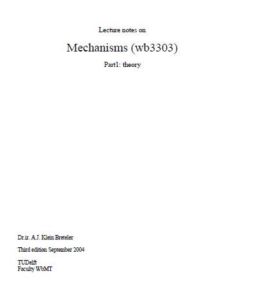Designers of machinery widely recognize that non-uniform motion is a difficult topic. The
purpose of this course is then to enlarge understanding of both the typical opportunities and
the problems involved with the application of mechanisms. Kinematics and dynamics of
linkages, i.e. the analysis of motion and force behaviour of link mechanisms, plays an
essential role in the design process and is the topic of this lecture.
For practical reasons the attention will be limited to planar linkages, including the types with
slider pairs and rolling contact (pair of gears, pinion and rack). Structure theory (chapter2)
shows that an unlimited number of planar mechanism types can be specified which might
challenge a designer for all kinds of application.
Mechanism science exists already since several centuries, originally mainly based on
graphical methods for motion analysis. These methods comprise much knowledge in a
compact and visual form and are therefore still valuable, not only for understanding kinematic
behaviour but also for expressing relations for design (dimensional synthesis of mechanisms).
Chapters 3 and 4 present a lecturer’s choice of the graphical methods, enhanced by analytical
treatment as suited for programming purpose.
With the introduction of the digital computer (since about 1970) numerical calculation
methods became more interesting. Research activities at the TU Delft, started by Besseling
and Van der Werff, resulted in a (finite) element approach, dedicated to both kinematic and
dynamic analysis of linkages. Computer programs based on this approach allow a user to
perform analysis of any type of mechanism, fast and accurate. Runmec is the program to be
used with this lecture. Its results can be presented in graphical form, to support the designer
with understanding the motion and force behaviour and thereby with his design and
construction decisions. Chapters 5 (kinematics) and 8 (dynamics) deal with explanation of the
theory and provide some examples of modelling mechanisms.
Extension of the FEM-approach concerns numerical optimisation (Klein Breteler). The
problem is reversed: for a given output motion the best kinematic dimensions of the links, of a
given type of mechanism, are to be calculated. It allows the user to concentrate on the
question “which mechanism type is best suited” because it becomes easy to perform
numerical experiments with different mechanisms. In chapter 6 the theory is summarized and
the mental concept of optimising mechanisms is explained.
Computer controlled driving became also more interesting in the past decades. Direct
application of output motion to the working element is usually not possible. The mechanism
for motion transfer can sometimes, not only for constructional reasons, advantageously be of
the non-uniform type. The combination “controlled drive and mechanism” requires that
kinematics can inversely be performed (input and output interchanged). Chapter 7 presents
the theory and examples of inverse kinematics. Planar robots are also covered by this theory.
In Collection
#5614
Read It:
Yes
#5614
Read It:
Yes
|
|
||||
